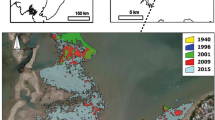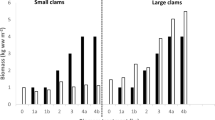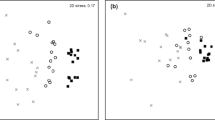Abstract
One method of preserving beaches against the effects of erosion and sea level rise is beach renourishment. While there have been many studies assessing the impact of renourishment on macrofauna, few studies have looked at its effects on microbes. Benthic microalgae (BMA) are important primary producers, representing the basis of nearshore food webs. BMA also secrete extracellular polymeric substances (EPS), which bind sediment and thus help prevent erosion. The objective of this study was to monitor recovery of BMA in terms of relative biomass (estimated as sediment chlorophyll a) and community structure (characterized using high-throughput DNA sequencing) following renourishment of Folly Beach, SC in 2014. We also examined the relationships among biomass, EPS, and erosion. Sediment samples were collected intermittently (n = 9) from two renourished and two control sites within three intertidal zones (high, mid, low) from June 2014 to January 2015. Biomass recovered in sequence from low to high intertidal, corresponding to when the artificially-raised beach once again experienced regular tidal inundation (between 93 and 169 days post-renourishment). Alpha diversity metrics misleadingly indicated recovery around this same time within the high intertidal, but compositional changes through time were unlike those seen in control samples, and these communities had yet to recover at ~ 7 months post-renourishment. Renourishment therefore appears to impact BMA communities via artificial elevation of the beach face. While there were relationships between chl a, EPS, and erosion, BMA most likely play a minimal role in sediment stabilization in high-energy environments like Folly Beach.








Similar content being viewed by others
References
Baulch, H.M., M.A. Turner, D.L. Findlay, R.D. Vinebrooke, and W.F. Donahue. 2009. Benthic algal biomass—Measurement and errors. Canadian Journal of Fishers and Aquatic Sciences. 66 (11): 1989–2001.
Bézy, V.S., R.A. Valverde, and C.J. Plante. 2014. Olive ridley sea turtle hatching success as a function of microbial abundance and the microenvironment of in situ nest sand at Ostional, Costa Rica. Journal of Marine Biology. 2014: 1–10. https://doi.org/10.1155/2014/351921.
Cahoon, L.B., J.E. Nearhoof, and C.L. Tilton. 1999. Sediment grain size effect on benthic microalgal biomass in shallow aquatic ecosystems. Estuaries 22 (3): 735–741.
Cahoon, L.B., E.S. Carey, and J.E. Blum. 2012. Benthic microalgal biomass on ocean beaches: Effects of sediment grain size and beach renourishment. Journal of Coastal Research 28: 853–859.
Caporaso, J.G., J. Kuczynski, J. Stombaugh, K. Bittinger, F.D. Bushman, E.K. Costello, N. Fierer, A.G. Pena, J.K. Goodrich, J.I. Gordon, G.A. Huttley, S.T. Kelley, D. Knights, J.E. Koenig, R.E. Ley, C.A. Lozupone, D. McDonald, B.D. Muegge, M. Pirrung, J. Reeder, J.R. Sevinsky, P.J. Turnbaugh, W.A. Walters, J. Widmann, T. Yatsunenko, J. Zaneveld, and R. Knight. 2010a. QIIME allows analysis of high-throughput community sequencing data. Nature Methods 7 (5): 335–336.
Caporaso, J.G., K. Bittinger, F.D. Bushman, T.Z. DeSantis, G.L. Andersen, and R. Knight. 2010b. PyNAST: A flexible tool for aligning sequences to a template alignment. Bioinformatics 26 (2): 266–267.
Chao, A. 1984. Non-parametric estimation of the number of classes in a population. Scandinavian Journal of Statistics 11: 265–270.
City of Folly Beach. 2015. 2015 local comprehensive beach management plan. 131 pp. https://www.scdhec.gov/sites/default/files/docs/HomeAndEnvironment/Docs/State-ApprovedLCBMP.pdf. Accessed 21 Sept 2018.
Clarke, K.R. 1993. Non-parametric multivariate analysis of changes in community structure. Australian Journal of Ecology 18 (1): 117–143.
Clarke, K.R., and R.N. Gorley. 2001. PRIMER v5: User manual/tutorial. Plymouth: PRIMER-E.
Decho, A.W. 1990. Microbial exopolymer secretions in ocean environments: Their role(s) in food webs and marine processes. Oceanography and Marine Biology: An Annual Review 28: 73–153.
Edgar, R.C. 2010. Search and clustering orders of magnitude faster than BLAST. Bioinformatics 26 (19): 2460–2461.
Edgar, R.C., B.J. Haas, J.C. Clemente, C. Quince, and R. Knight. 2011. UCHIME improves sensitivity and speed of chimera detection. Bioinformatics 27 (16): 2194–2200.
Folk, R.L., and W. Ward. 1957. Brazos River bar: A study in the significance of grain size parameters. Journal of Sedimentary Petrology 27 (1): 3–26.
Forster, R.M., V. Créach, K. Sabbe, W. Vyverman, and L.J. Stal. 2006. Biodiversity-ecosystem function relationship in microphytobenthic diatoms of the Westerschelde estuary. Marine Ecology Progress Series 311: 191–201.
Heip, C. 1974. A new index measuring evenness. Journal of the Marine Biological Association of the United Kingdom 54 (03): 555–557.
Hernandez, R.J., Y. Hernandez, N.H. Jimenez, A.M. Piggot, J.S. Klaus, Z. Feng, A. Reniers, and H.M. Solo-Gabriele. 2014. Effects of full-scale beach renovation on fecal indicator levels in shoreline sand and water. Water Research 48: 579–591.
Holland, A.F., R.G. Zingmark, and J.M. Dean. 1974. Quantitative evidence concerning the stabilization of sediments by marine benthic diatoms. Marine Biology 27 (3): 191–196.
Levine, N., C. Kaufman, M. Katuna, S. Harris, and M. Colgan. 2009. Folly Beach, South Carolina: An endangered barrier island. In Kelley, J.T., O.H. Pilkey, J.A.G. Cooper, eds., America’s most vulnerable coastal communities: Geological society of america special paper 460, p. 91–110, https://doi.org/10.1130/2009.2460(06).
Lozupone, C., and R. Knight. 2005. UniFrac: A new phylogenetic method for comparing microbial communities. Applied and Environmental Microbiology 71 (12): 8228–8235.
Lubarsky, H.V., C. Hubas, M. Chocholek, F. Larson, W. Manz, D.M. Paterson, and S.U. Gerbersdorf. 2010. The stabilization potential of individual and mixed assemblages of natural bacteria and microalgae. PLoS One 5 (11). https://doi.org/10.1371/journal.pone.0013794.
Luddington, I.A., I. Kaczmarska, and C. Lovejoy. 2012. Distance and character-based evaluation of the V4 region of the 18S rRNA gene for the identification of diatoms (Bacillariophyceae). PLoS One 7 (9). https://doi.org/10.1371/journal.pone.0045664.
MacIntyre, H.L., R.J. Geider, and D.C. Miller. 1996. Microphytobenthos: The ecological role of the "secret garden" of unvegetated, shallow-water marine habitats. I. Distribution, abundance and primary production. Estuaries and Coasts 19 (2): 186–201.
Madsen, K.N., P. Nilsson, and K. Sundbäck. 1993. The influence of benthic microalgae on the stability of a subtidal sediment. Journal of Experimental Marine Biology and Ecology 170 (2): 159–177.
McLachlan, A., T. Wooldridge, and A.H. Dye. 1981. The ecology of sandy beaches in southern Africa. South African Journal of Zoology 16 (4): 219–231.
Miller, D.C., R.J. Geider, and H.L. MacIntyre. 1996. Microphytobenthos: The ecological role of the “Secret Garden” of unvegetated, shallow-water marine habitats. II. Role in sediment stability and shallow-water food webs. Estuaries 19 (2): 202–212.
Nelson, W.G. 1993. Beach restoration in the southeastern US: Environmental effects and biological monitoring. Ocean and Coast Management 19 (2): 157–182.
Nelson, J.R., J.E. Eckman, C.Y. Robertson, R.L. Marinelli, and R.A. Jahnke. 1999. Benthic microalgal biomass and irradiance at the sea floor on the continental shelf of the South Atlantic Bight: Spatial and temporal variability and storm effects. Continental Shelf Research 19 (4): 477–505.
Nilsson, C. 1995. Microbenthic communities with emphasis on algal-nutrient relations. PhD dissertation. Göteborg, Sweden: Göteborg University.
Peterson, C.H., and M.J. Bishop. 2005. Assessing the environmental impacts of beach nourishment. BioScience 55 (10): 887–896.
Plante, C.J., V. Fleer, and M.L. Jones. 2016. Neutral processes and species sorting in benthic microalgal community assembly: Effects of tidal resuspension. Journal of Phycology 52 (5): 827–839.
Price, M.N., P.S. Dehal, and A.P. Arkin. 2010. FastTree 2—Approximately maximum-likelihood trees for large alignments. PLoS One. https://doi.org/10.1371/journal.pone.0009490.
Quast, C., E. Pruesse, P. Yilmaz, J. Gerken, T. Schweer, P. Yarza, J. Peplies, and F.O. Glöckner. 2013. The SILVA ribosomal RNA gene database project: Improved data processing and web-based tools. Nucleic Acids Research 41: 590–596.
R Core Team. 2013. R: A language and environment for statistical computing. Vienna: R Foundation for Statistical Computing http://www.R-project.org/.
Sherrod, B.L. 1999. Gradient analysis of diatom assemblages in a Puget Sound salt marsh: Can such assemblages be used for quantitative paleoecological reconstructions? Palaeogeography, Palaeoclimatology, Palaeoecology 149 (1-4): 213–226.
Snigirova, A. 2013. Benthic microalgae under the influence of beach nourishment in the Gulf of Odessa (the Black Sea). Botanica Lithuanica 19 (2): 120–128.
Sousa, E.C.P.M., and C.J. David. 1996. Daily variation of microphytobenthos photosynthetic pigments in Aparecida Beach-Santos (23° 58′ 48′′ S, 46° 19′ 00′′ W), Sao Paulo, Brazil. Revista Brazileira de Biologia 56: 147–154.
Speybroeck, J.D., D. Bonte, W. Courtens, T. Gheskiere, P. Grootaert, J. Maelfait, M. Mathys, S. Provoost, K. Sabbe, E.W.M. Stienen, V. van Lancker, M. Vincx, and S. Degraer. 2006. Beach nourishment: An ecologically sound coastal defense alternative? A review. Aquatic Conservation 16 (4): 419–435.
Stal, L.J. 2010. Microphytobenthos as a biogeomorphological force in intertidal sediment stabilization. Ecological Engineering 36(2): 236–245.
Steele, J.H., and I.E. Baird. 1968. Production ecology of a sandy beach. Limnology and Oceanography 13: 14–25.
Thistle, D., G.L. Weatherly, and S.C. Ertman. 1995. Shelf harpacticoid copepods do not escape into the seabed during winter storms. Journal of Marine Research 53 (5): 847–863.
Tolhurst, T.J., B. Jesus, V. Brotas, and D.M. Paterson. 2003. Diatom migration and sediment armouring—An example from the Tagus Estuary, Portugal. Hydrobiologia 503 (1-3): 183–193.
Underwood, G.J.C., and J. Kromkamp. 1999. Primary production by phytoplankton and microphytobenthos in estuaries. Advances in Ecological Research 29: 93–153.
Underwood, G.J.C., and D.J. Smith. 1998. Predicting epipelic diatom exopolymer concentrations in intertidal sediments from sediment chlorophyll a. Microbial Ecology 35: 116–125.
Underwood, G.J.C., D.M. Paterson, and R.J. Parkes. 1995. The measurement of microbial carbohydrate exopolymers from intertidal sediments. Limnology and Oceanography 40 (7): 1243–1253.
USACE. 2013. Environmental assessment draft, Folly Beach shore protection project and use of outer continental shelf sand, Charleston County, SC. 160 pp. http://www.sac.usace.army.mil/Portals/43/docs/civilworks/nepadocuments/FollyBeachRenourishmentDraftEA2013-withAppendices.pdf. Accessed 21 September 2018.
Valverde, H.R., A.C. Trembanis, and O.H. Pilkey. 1999. Summary of beach nourishment episodes on the U S. East Coast barrier islands. Journal of Coastal Research 15: 1100–1118.
van der Wal, D., A. Wielemaker-van den Dool, and P.M.J. Herman. 2010. Spatial synchrony in intertidal benthic algal biomass in temperate coastal and estuarine ecosystems. Ecosystems 13: 338–351.
Vanelslander, B., A. de Wever, N. van Oostende, P. Kaewnuratchadasorn, P. Vanormelingen, F. Hendrickx, K. Sabbe, and W. Vyverman. 2009. Complementarity effects drive positive diversity effects on biomass production in experimental benthic diatom biofilms. Journal of Ecology 97 (5): 1075–1082.
Vázquez-Baeza, Y., M. Pirrung, A. Gonzalez, and R. Knight. 2013. EMPeror: A tool for visualizing high-throughput microbial community data. GigaScience 2 (1): 16.
Wang, Q., G.M. Garrity, J.M. Tiedje, and J.R. Cole. 2007. Naïve Bayesian classifier for rapid assignment of rRNA sequences into the new bacterial taxonomy. Applied and Environmental Microbiology 73 (16): 5261–5267.
Weckström, K., and S. Juggins. 2005. Coastal diatom-environment relationships from the Gulf of Finland, Baltic Sea. Journal of Phycology 42: 21–35.
Welschmeyer, N.A. 1994. Fluorometric analysis of chlorophyll a in the presence of chlorophyll b and phaeopigments. Limnology and Oceanography 39 (8): 1985–1992.
Yallop, M.L., D.M. Paterson, and P. Wellsbury. 2000. Interrelationships between rates of microbial production, exopolymer production, microbial biomass, and sediment stability in biofilms of intertidal sediments. Microbial Ecology 39 (2): 116–127.
Zimmermann, J., R. Jahn, and B. Gemeinholzer. 2011. Barcoding diatoms: Evaluation of the V4 subregion on the 18S rRNA gene, including new primers and protocols. Organisms Diversity & Evolution 11 (3): 173–192.
Acknowledgments
We thank the Great Lakes Dredge and Dock Company and the US Army Corps of Engineers for providing access to field sites. We also thank Jennifer Ness at the National Institute of Standards and Technology’s Material Measurement Laboratory for providing training on the Malvern Mastersizer 3000 for particle size analyses and the Hollings Marine Laboratory for access to the facility. Morgan Larimer and Caroline Cooper provided both laboratory and field assistance. Kevin Spanik, Stacy Krueger-Hadfield, Meredith Smylie, Nathan Butcher, and Paige Bippus also provided field assistance. This is Grice Marine Laboratory publication 511.
Funding
This work was funded by a Summer Research with Faculty (SURF) grant at The College of Charleston, Charleston, SC. We would also like to acknowledge the Proteogenomics Facility supported by the National Institutes of Health Grants (P30GM103342, P20GM103499) and MUSC’s Office of the Vice President for Research.
Author information
Authors and Affiliations
Corresponding author
Ethics declarations
Conflict of Interest
The authors declare that they have no conflict of interest.
Additional information
Communicated by Deana Erdner
Electronic Supplementary Material
ESM 1
(DOCX 21 kb)
Supplementary Fig. 1
Median grain size (μm) of sediment collected from control and renourished sites from the a high and b low intertidal zones from June 2014 to January 2015. Samples were sieved (< 1 mm) before analysis to remove shell hash. Error bars represent standard error (PDF 38 kb)
Supplementary Fig. 2
Mean percent silt-clay in sediment collected from control and renourished sites from a both the high and low intertidal zones, b the high, and c low intertidal zones from June 2014 to January 2015. Error bars represent standard error (PDF 40 kb)
Supplementary Fig. 3
Mean percent shell hash by volume in sediment collected from control and renourished sites from a both the high and low intertidal zones, b the high, and c low intertidal zones from June 2014 to January 2015. Error bars represent standard error (PDF 40 kb)
Supplementary Fig. 4
Mean inclusive graphic standard deviation (σ1), a measurement of particle sorting, of sediment samples collected from control and renourished sites from a both the high and low intertidal zones, b the high, and c low intertidal zones from June 2014 to January 2015. All control (C1 and C2) and renourished (R1 and R2) sites are represented for the high intertidal zone because there was a significant difference between the two control replicates. Data from replicate sites were otherwise averaged. σ1 < 0.350, Φ = very well sorted, and > 4.00Φ = extremely poorly sorted (Folk and Ward 1957). Error bars represent standard error (PDF 153 kb)
Supplementary Fig. 5
Principal coordinate analysis plot of unweighted UniFrac distances of samples collected from the control and renourished sites from the low intertidal zone from five sampling dates. Groupings are defined based on analysis of similarity results (Supplementary Table 3). t = days post-renourishment (PNG 88 kb)
Supplementary Fig. 6
Mean maximum erosion measurements taken 24 h after erosion pin deployment at the a high intertidal, b mid intertidal, and c low intertidal zones renourished (R1, R2) and control (C1) sites and mean wind speed by sampling date. Wind data were collected at NOAA Buoy Station FBIS1 (32° 41′ 6″ N 79° 53′ 18″ W) operated by the National Data Buoy Center (http://www.ndbc.noaa.gov/station_page.php?station=fbis1). Note the difference in scale for the high intertidal zone. Error bars represent standard error (PDF 102 kb)
Rights and permissions
About this article
Cite this article
Hill-Spanik, K.M., Smith, A.S. & Plante, C.J. Recovery of Benthic Microalgal Biomass and Community Structure Following Beach Renourishment at Folly Beach, South Carolina. Estuaries and Coasts 42, 157–172 (2019). https://doi.org/10.1007/s12237-018-0456-x
Received:
Revised:
Accepted:
Published:
Issue Date:
DOI: https://doi.org/10.1007/s12237-018-0456-x




